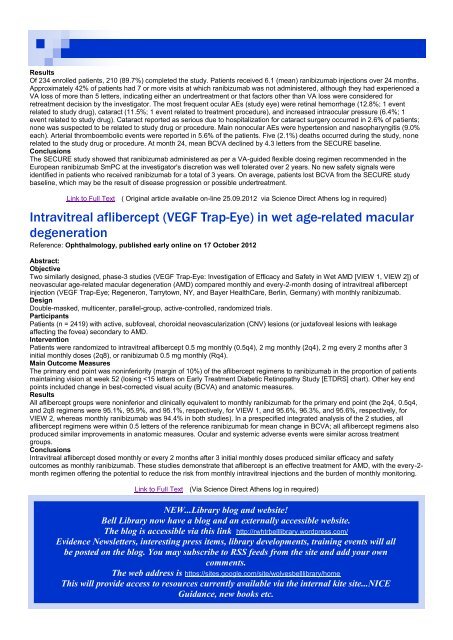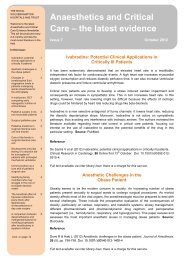Eyes and Vision - The Royal Wolverhampton NHS Trust Library ...
Eyes and Vision - The Royal Wolverhampton NHS Trust Library ...
Eyes and Vision - The Royal Wolverhampton NHS Trust Library ...
You also want an ePaper? Increase the reach of your titles
YUMPU automatically turns print PDFs into web optimized ePapers that Google loves.
Results<br />
Of 234 enrolled patients, 210 (89.7%) completed the study. Patients received 6.1 (mean) ranibizumab injections over 24 months.<br />
Approximately 42% of patients had 7 or more visits at which ranibizumab was not administered, although they had experienced a<br />
VA loss of more than 5 letters, indicating either an undertreatment or that factors other than VA loss were considered for<br />
retreatment decision by the investigator. <strong>The</strong> most frequent ocular AEs (study eye) were retinal hemorrhage (12.8%; 1 event<br />
related to study drug), cataract (11.5%; 1 event related to treatment procedure), <strong>and</strong> increased intraocular pressure (6.4%; 1<br />
event related to study drug). Cataract reported as serious due to hospitalization for cataract surgery occurred in 2.6% of patients;<br />
none was suspected to be related to study drug or procedure. Main nonocular AEs were hypertension <strong>and</strong> nasopharyngitis (9.0%<br />
each). Arterial thromboembolic events were reported in 5.6% of the patients. Five (2.1%) deaths occurred during the study, none<br />
related to the study drug or procedure. At month 24, mean BCVA declined by 4.3 letters from the SECURE baseline.<br />
Conclusions<br />
<strong>The</strong> SECURE study showed that ranibizumab administered as per a VA-guided flexible dosing regimen recommended in the<br />
European ranibizumab SmPC at the investigator's discretion was well tolerated over 2 years. No new safety signals were<br />
identified in patients who received ranibizumab for a total of 3 years. On average, patients lost BCVA from the SECURE study<br />
baseline, which may be the result of disease progression or possible undertreatment.<br />
Link to Full Text ( Original article available on-line 25.09.2012 via Science Direct Athens log in required)<br />
Intravitreal aflibercept (VEGF Trap-Eye) in wet age-related macular<br />
degeneration<br />
Reference: Ophthalmology, published early online on 17 October 2012<br />
Abstract:<br />
Objective<br />
Two similarly designed, phase-3 studies (VEGF Trap-Eye: Investigation of Efficacy <strong>and</strong> Safety in Wet AMD [VIEW 1, VIEW 2]) of<br />
neovascular age-related macular degeneration (AMD) compared monthly <strong>and</strong> every-2-month dosing of intravitreal aflibercept<br />
injection (VEGF Trap-Eye; Regeneron, Tarrytown, NY, <strong>and</strong> Bayer HealthCare, Berlin, Germany) with monthly ranibizumab.<br />
Design<br />
Double-masked, multicenter, parallel-group, active-controlled, r<strong>and</strong>omized trials.<br />
Participants<br />
Patients (n = 2419) with active, subfoveal, choroidal neovascularization (CNV) lesions (or juxtafoveal lesions with leakage<br />
affecting the fovea) secondary to AMD.<br />
Intervention<br />
Patients were r<strong>and</strong>omized to intravitreal aflibercept 0.5 mg monthly (0.5q4), 2 mg monthly (2q4), 2 mg every 2 months after 3<br />
initial monthly doses (2q8), or ranibizumab 0.5 mg monthly (Rq4).<br />
Main Outcome Measures<br />
<strong>The</strong> primary end point was noninferiority (margin of 10%) of the aflibercept regimens to ranibizumab in the proportion of patients<br />
maintaining vision at week 52 (losing




